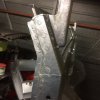- Posts
- 337
- Location
- Poole Dorset
Hi folks,
I picked up my Bulkhead, radiator panel and sills from the galving people.
£115 complete. I thought the guy quoted me £150 plus vat.
Issues...A few spots look not done. probably the shot blasting.
Next...Where I had butt welded some panels together, they stand out where I had welded. These will be visible above the bonnet.
After the shotblasting they were smooth. The galvanize process must do something to it.
I think I will have to resort to a bit of filler to smooth it out a bit.
My intentions were to twash and hand coat epoxy primer before topcoat.
Any thoughts on the primer being thick enough to smooth out any slight imperfections to avoid filler?
I dont see any panel rippling at all so no complaint there.
cheere peter
I picked up my Bulkhead, radiator panel and sills from the galving people.
£115 complete. I thought the guy quoted me £150 plus vat.
Issues...A few spots look not done. probably the shot blasting.
Next...Where I had butt welded some panels together, they stand out where I had welded. These will be visible above the bonnet.
After the shotblasting they were smooth. The galvanize process must do something to it.
I think I will have to resort to a bit of filler to smooth it out a bit.
My intentions were to twash and hand coat epoxy primer before topcoat.
Any thoughts on the primer being thick enough to smooth out any slight imperfections to avoid filler?
I dont see any panel rippling at all so no complaint there.
cheere peter


